Cybex Pallas 2 User Manual [it]
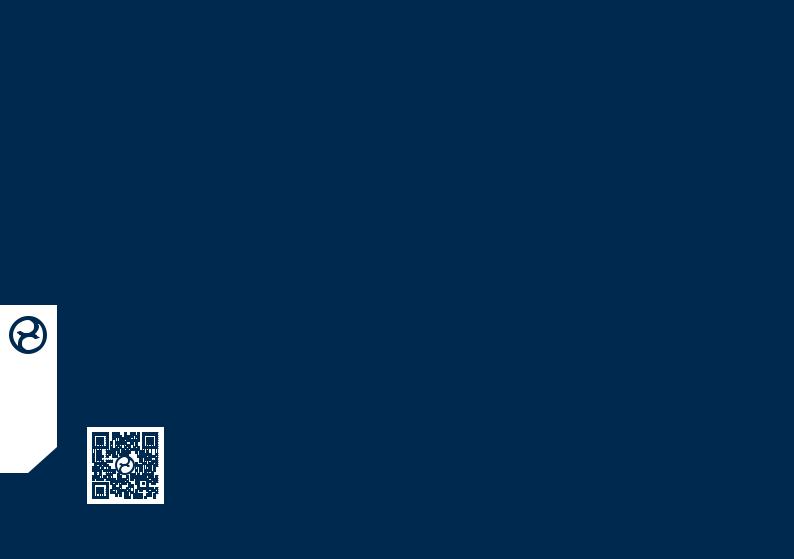
CYBEX GmbH
Riedinger Str. 18 | 95448 Bayreuth | Germany
info@cybex-online.com www.cybex-online.com www.facebook.com/cybex.online
go to www.cybex-online.com
to watch an instructional video
C223_891-1_01D
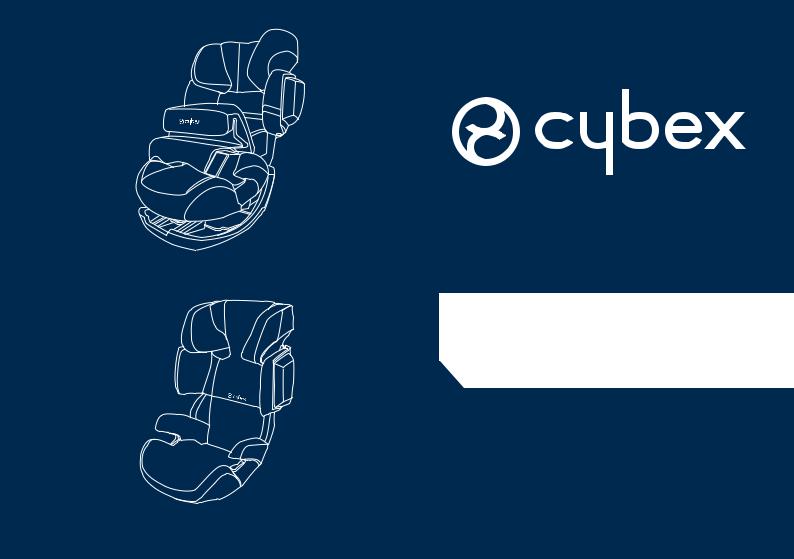
CYBEX Pallas 2 | ECE R44/04, Gr. 1 – 9-18 kg (ca. 9M–4Y)
CYBEX Pallas 2
USER GUIDE
DE / UK / IT / FR / NL / PL / HU / CZ / SK 
CYBEX Solution X2 | ECE R44/04, Gr. 2/3 – 15-36 kg (ca. 3–12Y)
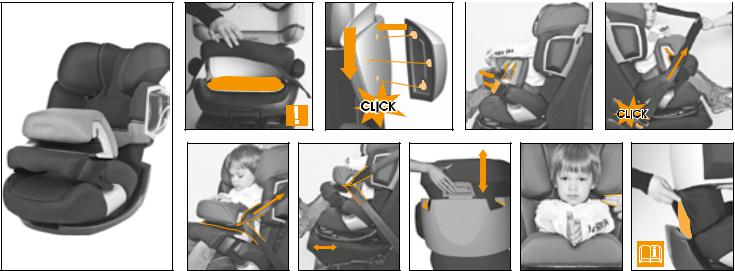
DE – Gruppe 1 (9-18 kg) / UK – Group 1 (9-18 kg) / IT – Gruppo 1 (9-18 kg)/ FR – Groupe 1 (9 à 18 kg) / NL – Groep 1 (9-18 kg) / PL – Grupa 1 (9-18 kg) / HU – 1. csoport (9-18 kg) / CZ – Skupina 1 (9-18kg) / SK – Skupina 1 (9-18 kg)
DE – Kurzanleitung / UK – Short manual / IT – Sommario / FR – Instructions sommaires / NL – Beknopte handleiding / PL – Instrukcja skrócona / HU – rövid ismertetés / CZ – krátké instrukce / SK – Krátky manuál
DE
UK
IT
FR
NL
Warnung! Diese Kurzanleitung dient nur der übersicht. Für maximalen Schutz und Komfort Ihres Kindes ist es unbedingt notwendig, die gesamte Gebrauchsanleitung aufmerksam zu lesen.
Warning! This short manual serves as an overview only. For maximum protection and best comfort for your child, it is essential to read and follow the entire instruction manual carefully.
Attenzione! Queste istruzioni sono solo un sommario. Per garantire la massima sicurezza e comfort al Vostro bambino è molto importante leggere attentamente ed interamente il manuale d’istruzioni e seguirne scrupolosamente le indicazioni.
Attention! Ces instructions sommaires sont une synthèse. Afin que votre enfant bénéficie d’un maximum de protection et de confort, il est essentiel de lire attentivement l’intégralité du manuel d’utilisation.
Waarschuwing! Deze beknopte handleiding dient uitsluitend als overzicht. Voor maximale bescherming en optimaal comfort voor uw kind is het van essentieel belang dat u de gehele instructiehandleiding aandachtig doorleest en nauwgezet opvolgt.
1
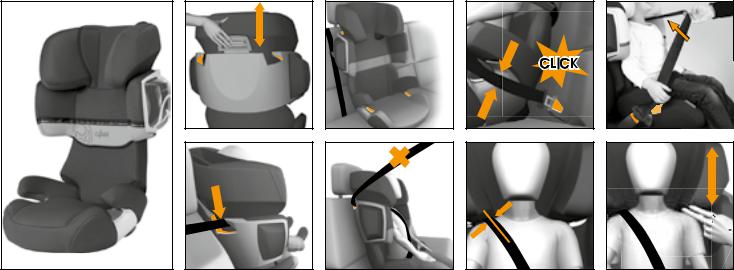
DE – Gruppe 2/3 (15-36 kg) / UK – Group 2/3 (15-36 kg) / IT – Gruppo 2/3 (15-36 kg) / FR – Groupe 2/3 (15 à 36 kg) / NL – Groep 2/3 (15-36 kg) / PL – Grupa 2/3 (15-36 kg) / HU – 2./3. csoport (15-36 kg) / CZ – Skupina 2/3 (15-36kg) / SK – Skupina 2/3 (15-36 kg)
DE – Kurzanleitung / UK – Short manual / IT – Sommario / FR – Instructions sommaires / NL – Beknopte handleiding / PL – Instrukcja skrócona / HU – rövid ismertetés / CZ – krátké instrukce / SK – Krátky manuál
PL
HU
CZ
SK
Ostrzeżenie! Instrukcja ta jest tylko obrazkowym streszczeniem. Aby zagwarantować swojemu dziecku maksymalne bezpieczeństwo i wygodę, należy uważnie przeczytać całą instrukcję.
Figyelem! Ez a rövid kézikönyv csak áttekintésül szolgál. A gyermeke maximális védelme és legjobb kényelme érdekében elengedhetetlen a teljes használati utasítás elolvasása és gondos betartása.
Varování! Tyto krátké instrukce slouží pouze jako přehled. Pro maximální ochranu a pohodlí dítěte je nezbytné si důkladně přečíst celý návod k použití a řídit se jím.
Varovanie! Tieto krátke inštrukcie slúži len jako prehľad. Pre maximálnu ochranu a pohodlie dieťata je potrebné si dôkladne prečítať celý návod na použitie a riadiť sa ním.
2


Sehr geehrte Kundin, sehr geehrter Kunde!
Vielen Dank, dass Sie sich bei der Wahl eines Kindersitzes für den CYBEX Pallas 2 entschieden haben.
Bei der Entwicklung des CYBEX Kindersitzes Pallas 2 haben Sicherheit, Komfort und Bedienfreundlichkeit im Vordergrund gestanden.
Dear Customer!
Thank you for purchasing the CYBEX Pallas 2.
We assure you that in the process of developing the CYBEX Pallas 2 we focused on safety, comfort and user friendliness. The product is manufactured under special quality surveillance and complies with the strictest safety requirements.
Gentile cliente!
Ci congratuliamo con Lei per avere acquistato il seggiolino CYBEX Pallas 2.
Le assicuriamo che nel progettare CYBEX Pallas 2 i nostri principali obiettivi sono stati la sicurezza, il comfort e la maneggevolezza. Il prodotto è stato elaborato sotto uno stretto controllo qualitativo e risponde ai più severi standard di sicurezza.

Cybex Pallas 2 Kinderautositz -
Sitzerhöher mit Rückenlehne und Kopfstütze auf einem verstellbaren Grundrahmen mit tiefenverstellbarem Sicherheitskissen.
Empfohlen für:
Alter: Ca. 9 Monate bis 4 Jahre Gewicht: 9-18 kg
Für Fahrzeugsitze mit Dreipunkt Automatik Gurt
Zulassung:
ECE R-44/04,
CYBEX Pallas 2 - Gruppe 1, 9 bis 18 kg CYBEX Solution X2 - Gruppe 2/3, 15 bis 36 kg
Cybex Pallas 2 Child Restraint System –
Seat Cushion with backrest and headrest on adjustable main frame with an adjustable safety cushion.
Recommended for:
Age: Approximately 9 months to 4 years Weight: 9 to 18 kg
For vehicle seats with three-point automatic retractor belt
Homologation:
ECE R-44/04,
CYBEX Pallas 2 - Group 1, 9 to 18 kg CYBEX Solution X2 - Group 2/3, 15 to 36 kg
|
Cybex Pallas 2, sistema di ritenuta per bambini |
|
Base di seduta con schienale e appoggiatesta, su |
|
struttura base regolabile, con cuscino anticrash |
|
regolabile. |
|
Raccomandato per: |
|
Età: da 9 mesi a 4 anni circa |
|
Peso: da 9 a 18 kg |
|
Per autoveicoli con sedili dotati di cinture di sicurezza |
|
automatiche a tre punti |
|
Omologazione: |
|
ECE R-44/04, |
11/2013 |
CYBEX Pallas 2 - Gruppo 1, da 9 a 18 kg |
CYBEX Solution X2 - Gruppo 2/3, da 15 a 36 kg |
DE INHALT
Warnung! Um den optimalen Schutz für Ihr Kind zu gewährleisten, muss der CYBEX Kindersitz unbedingt so verwendet werden, wie es in dieser Anleitung beschrieben wird.
Hinweis! Bewahren Sie die Anleitung immer griffbereit auf (z. B. unter dem elastischen Bezug an der Rückseite der Rückenlehne).
Hinweis! Durch länderspezifische Anforderungen können Produktmerkmale abweichen.
Kurzanleitung Altersgruppe 1........................................................................................................ |
1 |
Kurzanleitung Altersgruppe 2/3..................................................................................................... |
2 |
Zulassung......................................................................................................................................... |
5 |
Erstmontage.................................................................................................................................... |
7 |
Der richtige Platz im Fahrzeug....................................................................................................... |
7 |
Den Sitz ins Fahrzeug stellen........................................................................................................... |
9 |
Anpassen an Körpergrösse............................................................................................................ |
9 |
Entnehmen des Sitzerhöhers.......................................................................................................... |
9 |
Einstellen des Sicherheitskissens – ECE Gruppe 1 (9 - 18 kg)..................................................... |
11 |
Sitzund Liegeposition – ECE Gruppe 1 (9-18 kg)...................................................................... |
11 |
Einstellung der Kopfstütze............................................................................................................ |
11 |
Anschnallen mittels Sicherheitskissen - ECE Gruppe 1 (9-18 kg).............................................. |
13 |
Umbau von Gruppe 1 (9-18 kg) zu Gruppe 2/3 (15-36 kg)....................................................... |
13 |
Anschnallen ohne Sicherheitskissen - ECE Gruppe 2/3 (15-36 kg).......................................... |
15 |
Ist Ihr Kind richtig gesichert?......................................................................................................... |
15 |
Pflege............................................................................................................................................. |
17 |
Entfernen des Bezuges................................................................................................................. |
17 |
Entfernen des Sitzbezugs von der Sitzlehne............................................................................... |
17 |
Reinigung....................................................................................................................................... |
17 |
Verhalten nach einem Unfall...................................................................................................... |
19 |
Produktlebensdauer..................................................................................................................... |
19 |
Entsorgung..................................................................................................................................... |
19 |
Garantie........................................................................................................................................ |
21 |
5
UK |
CONTENT |
IT |
Argomenti |
Warning! For your child‘s maximum protection, it is essential to use and install the CYBEX child seat according to the instructions in this manual.
Note! Please keep the instruction manual close by for future reference (e.g. under the elastic cover on the rear side of the backrest)
Note! According to local codes the product characteristic can be different.
Attenzione! Per garantire un’adeguata sicurezza del Vostro bambino è molto importante che l’uso e l’installazione di CYBEX Pallas 2 siano effettuati seguendo scrupolosamente questo manuale d’istruzioni.
Nota Bene! Consigliamo di conservare il manuale istruzioni sotto la copertura elastica sul retro dello schienale in modo da averlo sempre a portata di mano per una veloce consultazione.
Nota Bene! In base alle normative locali alcune caratteristiche del prodotto potrebbero differire.
Short manual Group 1.................................................................................................................... |
1 |
Short manual Group 2/3................................................................................................................ |
2 |
Homologation................................................................................................................................. |
5 |
First installation................................................................................................................................. |
8 |
The best position in the car ........................................................................................................... |
8 |
Securing the child ........................................................................................................................ |
10 |
Adjustment to the body size ....................................................................................................... |
10 |
Removing the booster inlay......................................................................................................... |
10 |
Safety cushion adjustment - ECE group 1 (9-18 kg)................................................................. |
12 |
Seating and lie down position – ECE group 1 (9-18 kg)............................................................ |
12 |
Adjustment of the headrest........................................................................................................ |
12 |
Fastening of seatbelt with safety cushion attached - ECE group 1 (9-18 kg)........................ |
14 |
Change over from group 1 (9-18 kg) to group 2/3 (15-36 kg)................................................. |
14 |
Fastening of seat belt without the safety cushion - ECE group 2/3 (15-36 kg)....................... |
16 |
Is your child properly secured?................................................................................................... |
16 |
Product care................................................................................................................................. |
18 |
Removing the seat cover ........................................................................................................... |
18 |
Removing the seat cover of the backrest................................................................................. |
18 |
Cleaning ....................................................................................................................................... |
18 |
What to do after an accident..................................................................................................... |
20 |
Durability of the product.............................................................................................................. |
20 |
Disposal.......................................................................................................................................... |
20 |
Warranty........................................................................................................................................ |
22 |
Sommario Manuale Gruppo 1...................................................................................................... |
1 |
|
Sommario Manuale Gruppo 2/3................................................................................................... |
2 |
|
Omologazione - ammissibilità....................................................................................................... |
5 |
|
Prima installazione.......................................................................................................................... |
8 |
|
La posizione corretta all’interno dell’auto .................................................................................. |
8 |
|
Allacciare il bambino .................................................................................................................. |
10 |
|
Regolazione in base alla corporatura ....................................................................................... |
10 |
|
Rimozione dell‘inserto nella base seduta.................................................................................. |
10 |
|
Regolazione del cuscino anticrash – ECE Gruppo 1 (9-18 kg)................................................ |
12 |
|
Posizione di seduta e reclinazione – ECE Gruppo 1 (9-18 kg).................................................. |
12 |
|
Regolazione dell’appoggiatesta............................................................................................... |
12 |
|
Come allacciare la cintura di sicurezza con il cuscino anticrash: |
|
|
ECE - Gruppo 1 (9-18 kg).............................................................................................................. |
14 |
|
Passaggio da Gruppo 1 (9-18 kg) al Gruppo 2/3 (15-36 kg).................................................... |
14 |
|
Fastening of seat belt without the safety cushion - ECE group 2/3 (15-36 kg)....................... |
16 |
|
Il bambino è allacciato correttamente?................................................................................... |
16 |
|
Manutenzione............................................................................................................................... |
18 |
|
Rimozione del rivestimento seduta............................................................................................. |
18 |
|
Rimozione del rivestimento schienale........................................................................................ |
18 |
|
Pulizia.............................................................................................................................................. |
18 |
|
Come comportarsi dopo un incidente...................................................................................... |
20 |
|
Durevolezza prodotto.................................................................................................................. |
20 |
|
Smaltimento.................................................................................................................................. |
20 |
|
Garanzia........................................................................................................................................ |
22 |
6 |
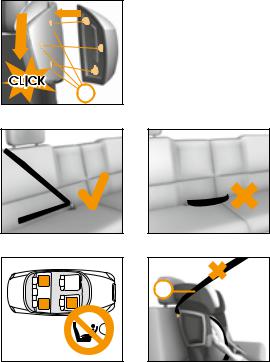
B |
f
ERSTmoNTAGE
Das „linear side Protection“ system (l.s.P.) wird für beide seiten in die montagebohrungen (b) gesteckt, dann nach unten geschoben, bis es einrastet.
DER RICHTIGE PLATZ Im FAHRZEUG
Der CYbeX kindersitz ist auf allen Plätzen mit Dreipunkt - automatikgurt verwendbar. Wir empfehlen generell, den sitz hinten im fahrzeug zu verwenden. Vorne ist ihr kind bei einem unfall in den meisten fällen höheren gefahren ausgesetzt.
Warnung! Der Sitz ist nicht für die Verwendung mit einem 2-Punkt- oder Beckengurt geeignet. Wird der Sitz mit einem 2-Punkt-Gurt gesichert, kann es bei einem Unfall zu schweren oder gar tödlichen Verletzungen des Kindes kommen.
in ausnahmefällen kann der sitz jedoch auch vorne am beifahrersitz verwendet werden. beachten sie dabei die folgenden Punkte:
–bei fahrzeugen mit airbag sollten sie den beifahrersitz so weit wie möglich nach hinten schieben. beachten sie jedoch, dass der obere anlenkpunkt des fahrzeuggurtes hinter der gurtführung des kindersitzes bleibt.
–Die empfehlungen des fahrzeugherstellers sind unbedingt zu befolgen.
Warnung! Der Diagonalgurt (f) muss schräg nach hinten verlaufen und darf nie nach vorn zum oberen Gurtpunkt in Ihrem Fahrzeug führen. Sollte dies nicht einzustellen sein z.B. durch Vorschieben des Autositzes oder Verwendung auf einem anderen Sitzplatz, so ist der Kindersitz für dieses Fahrzeug nicht geeignet.
gepäckstücke oder andere gegenstände im fahrzeug, welche bei einem unfall Verletzungen verursachen können, müssen immer gut befestigt werden. sie können zu tödlichen geschossen im fahrzeug werden.
Warnung! Auf Fahrzeugplätzen, die quer zur Fahrtrichtung angeordnet sind, ist die Verwendung des Sitzes nicht zulässig. Auf rückwärtsgerichteten Fahrzeugsitzen, wie z.B. in einem Van oder minibus, ist die Verwendung zulässig, sofern der Fahrzeugsitz für die Beförderung eines Erwachsenen zugelassen ist. Zu Beachten ist, dass die Kopfstütze bei rückwärtsgerichtetem Einbau nicht entfernt werden darf! Der Kindersitz muss auch dann, wenn er nicht benutzt wird, immer mit dem Fahrzeuggurt befestigt sein. Bereits bei einer Notbremsung oder einem geringen Aufprall kann ein unbefestigter Sitz andere mitfahrer und Sie selbst verletzen.
Hinweis! bitte lassen sie ihr kind nie unbeaufsichtigt im fahrzeug zurück.
7
FIRST INSTALLATION
Insert the Linear Side-impact Protection (L.S.P. System) pads on both sides into the mounting holes (B), then push down until they click into place.
THE BEST POSITION IN THE CAR
The CYBEX child seat can be used on all vehicle seats with a three-point automatic retractor belt. We generally recommend using the seat in the back of the vehicle. In the front, your child is usually exposed to higher risks in case of an accident.
Warning! You must not use the CYBEX child seat with a two-point belt or a lap belt. When securing your child with a two-point belt, the child may sustain lethal injuries in an accident.
In exceptions, the child seat may be used on the passenger seat. Please note the following for such cases:
––In cars equipped with airbags you should push the passenger seat as far back as possible. Please make sure that the upper point of the vehicle seat belt stays behind the belt guide of the child seat.
––You must follow the recommendations of the vehicle manufacturer.
Warning! The seat belt (f) must run diagonally from the back and must never lead to the front to the upper belt point of the front seat of in your vehicle. Should you be unable to adjust this for example by pushing the seat to the front or by using the seat on a different seat in the car, then the child seat is not suitable for this vehicle.
Luggage or other objects in the vehicle which may cause injuries in an accident must always be secured properly. Loose parts may turn into deadly projectiles during an impact.
Warning! For vehicles with passenger seats that are positioned sideways, the use of this child seat is not allowed. For seats that are positioned against the direction of travel, e.g. in a van or a minibus, the use of the child seat is allowed, assuming the seat is approved to carry an adult. Please ensure that the headrest is not taken off when mounting the child seat on a passenger seat which is positioned against the direction of travel! The child seat must have the seat belt fastened even when not in use. This is necessary to avoid the driver or passenger getting injured by a loose child seat when making an emergency stop or in case of a crash.
Note! Please never leave your child unattended in the car.
PRIMA INSTALLAZIONE
Inserire i cuscinetti del Sistema L.S.P. (Protezione Lineare nell‘Impatto Laterale) negli appositi alloggiamenti (B) da ambo i lati e spingere verso il basso fino a sentire il click di collegamento avvenuto.
Posizionamento corretto del seggiolino all‘interno dell‘autoveicolo
Il seggiolino CYBEX Pallas 2 può essere utilizzato su qualsiasi sedile di autoveicolo dotato di sistema di cinture di sicurezza a tre punti di ancoraggio. Raccomandiamo normalmente di utilizzare il seggiolino nella parte posteriore dell’autoveicolo. Sul sedile anteriore il bambino è esposto a maggiori rischi in caso di incidente.
Attenzione! Il seggiolino non può essere utilizzato con cinture di sicurezza a due punti di ancoraggio o soltanto con quella per le gambe, perché in tal caso il bambino sarebbe esposto a lesioni letali in caso di incidente.
In casi eccezionali il seggiolino potrà essere fissato sul sedile del passeggero. In tal caso, preghiamo di notare quanto segue.
––Nei veicoli dotati di airbag è necessario arretrare il sedile del passeggero al massimo. Assicuratevi che il punto di attacco superiore delle cinture si trovi sempre dietro alla guida superiore del seggiolino.
––E’ indispensabile seguire le raccomandazioni del costruttore del veicolo.
Attenzione! La cintura di sicurezza (f) deve scorrere diagonalmente da dietro ed il puntopiùaltodevetrovarsisempredietroalseggiolino.Se,peresempio,nell’arretrare al massimo il sedile anteriore o sistemandolo in altra posizione nell’auto, il punto più alto della cintura non si trovasse dietro al s eggiolino, quest’ultimo non potrà essere utilizzato in tale veicolo.
Bagagli o altri oggetti presenti nell’abitacolo dovranno sempre essere ben fissati e disposti in modo da non costituire pericolo in caso di incidente.
Attenzione! Seggiolino NON utulizzabile su sedili orientati lateralmente. Per sedili orientati contro il senso di marcia, per es. van o minibis, l‘uso è possibile soltanto se tali sedili sono omologati per il trasporto di un adulto. Nei sedili orientati contro il senso di marcia NON togliere l‘appoggiatesta quando viene montato il seggiolino. Allacciare sempre il seggiolino con la cintura di sicurezza anche quando non in uso. In caso di frenata improvvisa o di incidente, il seggiolino non fissato può costituire un grave pericolo per il conducente o altri passeggeri.
Avvertenza! Non lasciare MAI il bambino incustodito nell’autovettura.
8
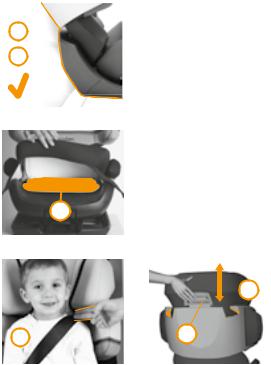
|
|
|
|
|
|
|
|
DEN SITZ INS FAHRZEUG STELLEN |
|
|
|
|
|
|
|
|
|
a |
|
|
|
|
|
|
|
Stellen Sie den Kindersitz auf den entsprechenden Fahrzeugsitz im Auto. |
|
|
|
|
|
–– Achten Sie unbedingt darauf, dass die Rückenlehne (a) des Kindersitzes flächig |
|||
|
|
|
|
|||||
r |
|
|
|
|
|
|
|
an der Rückenlehne des Autositzes anliegt, so dass sich der Kindersitz auf keinen |
|
|
|
|
Fall in einer Liegeposition befinden kann. |
||||
|
|
|
||||||
|
|
|
|
|
|
|
|
–– Sollte die Kopfstütze des Fahrzeugsitzes störend sein, ziehen Sie diese ganz heraus, |
|
|
|
|
|
|
|
|
drehen Sie sie um oder nehmen Sie sie ganz ab. Die Rückenlehne (a) passt sich |
|
|
|
|
|
|
|
|
optimal stufenlos fast jeder Neigung des Fahrzeugsitzes an. |
|
|
|
|
|
|
|
|
Warnung! Die Rückenlehne des CYBEX Kindersitzes muss an der Lehne des |
|
|
|
|
|
|
|
|
Fahrzeuges flächig aufliegen. Um den größtmöglichen Schutz für das Kind zu |
|
|
|
|
|
|
|
|
gewährleisten, muss sich der Sitz einer normalen aufrechten Position befinden! |
|
|
|
|
|
|
|
|
Hinweis! An einigen Autositzen aus empfindlichem Material (z.B. Velours, Leder, etc.) |
|
|
|
|
|
|
|
|
können durch die Benutzung von Kindersitzen mögliche Gebrauchsspuren und/ |
|
|
|
|
|
|
|
|
oder Abfärbungen auftreten. Um das zu vermeiden, können Sie z.B. eine Decke |
|
|
|
|
|
|
|
|
oder ein Handtuch unterlegen. Ferner weisen wir in diesem Zusammenhang auf |
|
|
|
|
|
|
|
|
unsere Reinigungshinweise hin, die vor der ersten Verwendung des Sitzes unbedingt |
|
|
|
i |
|
|
beachtet werden sollten. |
||
|
|
|
|
|
ANPASSEN AN DIE KÖRPERGRÖSSE |
|||
|
|
|
|
|
|
|
|
Um den CYBEX Kindersitz optimal an die Körpergröße anzupassen ist werkseitig ein |
|
|
|
|
|
|
|
|
Sitzerhöher (i) mitgeliefert und bereits unter dem Bezug eingelegt. |
|
|
|
|
|
|
|
|
|
|
|
|
|
|
|
|
|
–– Wir empfehlen diese Sitzeinlage (i) für Kinder vom 9. bis zum 18. Lebensmonat zu |
|
|
|
|
|
|
|
|
verwenden. |
|
|
|
|
|
|
|
|
|
|
|
|
|
|
|
|
|
–– Ab dem 19. Lebensmonat ist keine Sitzeinlage mehr notwendig. |
|
|
|
|
|
|
|
e |
–– Danach ist die Größenanpassung ausschließlich über die verstellbare Kopfstütze |
|
|
|
|
|
|
|
|
(e) vorzunehmen. Ziehen sie den Verstsellgriff (h) nach oben, um die Schulterund |
|
|
|
|
|
|
|
|
Kopfstütze zu entriegeln. |
|
|
|
|
|
|
|
h |
–– Die Anpassung hat so zu erfolgen, dass zwischen der unteren Kante der Kopfstütze |
f |
|
|
|
|
|
und der Schulter des Kindes noch 2 Fingerbreit Platz ist. |
||
|
|
|
|
|
Hinweis! Nur eine in optimaler Höhe eingestellte Schulterund Kopfstütze (e) bietet |
|||
|
|
|
|
|
|
|
|
|
|
|
|
|
|
|
|
|
den größtmöglichen Schutz und Komfort für Ihr Kind und gewährleistet außerdem |
|
|
|
|
|
|
|
|
den optimalen Verlauf des Diagonalgurtes (f). Die Höhenverstellung (e) kann in 11 |
|
|
|
|
|
|
|
|
Positionen erfolgen. Die Schulterstütze ist mit der Kopfstütze fest verbunden und muss |
|
|
|
|
|
|
|
|
nicht separat eingestellt werden. |
Entnehmen des Sitzerhöhers
1.Lösen Sie die vorderen beiden Druckknöpfe des Sitzbezugs vom Sitzkissen (d).
2.Ziehen Sie den Stoffbezug vorne hoch, bis Sie den Sitzerhöher nach vorne herausziehen können.
3.Entnehmen Sie den Sitzerhöher entsprechend der obigen Altersangabe.
4.Bringen Sie den Sitzbezug wieder in den ursprünglichen Zustand und befestigen Sie diesen anschließend wieder.
9
SECURING THE CHILD
Place the child seat on the respective seat in the car.
––Please make sure that the backrest (a) of the child seat rests flat against the backrest of the car seat so that the child seat is under no circumstances in a sleeping position.
––Should the headrest of the vehicle seat interfere, please pull it out completely and turn it around or take it off entirely. The backrest (a) optimally adjusts to almost any inclination of the vehicle seat.
Warning! The backrest of the CYBEX child seat should rest flat against the upright part of the car seat. Pushing the booster rearwards the seat should be tightly pressed against the seat. For the best possible protection of your child, the seat must be in a normal upright position!
Note! It is possible that some car seats that are made of soft material (e.g. velours, leather, etc.) may show signs of usage and/or discolouration. In order to avoid this, you could, for example, place a cover or towel underneath it. In this context, we would also like to refer to you to our cleaning instructions, which must absolutely be followed before the first use of the seat.
ADJUSTMENT TO THE BODY SIZE
For proper height adjustment of the CYBEX child seat an inlay (i) is included and already mounted under the seat cover when purchased.
––It is recommended to use this height adjustment inlay (i) between the age of 9 and 18 months.
––For children over 19 months the inlay may be removed
––Afterwards the height adjustment should be regulated by moving the headrest (e) into the correct position. Pull the slider (h) in order to release the headrest.
––The seat is correctly adjusted if you can fit 2 fingers between the bottom edge of the head rest and the shoulder of the child. Pull the adjustment handle (h) in order to unlock the shoulder and headrest.
Note! Only a shoulder and head rest (e) optimally adjusted in height provides the best protection and comfort for your child and also guarantees the optimal position of the diagonal belt (f). You can adjust the height (e) in 11 positions. The shoulder rest is attached to the head rest and does not have to be adjusted separately.
Removing the booster inlay
1.Open the forefront press buttons of the booster cover.
2.Lift the booster cover until the seat inlay can be easily removed from the front.
3.Remove the seat inlay according to the above age recommendation.
4.Put the seat cover back in its original position and fasten the press buttons.
Allacciare il bambino
Collocare il seggiolino di sicurezza sul sedile dell’auto.
––Prestare la massima attenzione affinché lo schienale del seggiolino (a) sia correttamente appoggiato al sedile dell’auto e non inclinato.
––Se l’appoggiatesta del sedile interferisce con il posizionamento del seggiolino di sicurezza sarà bene rialzarlo completamente o rimuoverlo. Lo schienale
(a)del seggiolino si adatta perfettamente a qualsiasi inclinazione del sedile dell’autoveicolo. Per la massima sicurezza del bambino il sedile deve trovarsi nella normale posizione eretta!
Attenzione! Lo schienale del seggiolino Pallas 2 dovrà essere perfettamente apppoggiato allo schienale dell‘auto. La base dovrà essere spinta all‘indietro contro il sedile.
Nota! Nel caso di sedili in materiali particolarmente delicati (per esempio velluto, pelle, ecc.) per evitare danneggiamenti consigliamo di di stendere un telo protettivo sotto il seggiolino. Con l‘occasione ricordiamo di fare riferimento anche alle istruzioni per il lavaggio, che devono essere seguite scrupolosamente prima dell‘utilizzo.
Regolazione in base alla corporatura
Il seggiolino è dotato di un inserto (i) per la corretta regolazione dell‘altezza. L‘inserto si trova sotto il rivestimento della seduta ed è premontato all‘acquisto.
––L‘uso dell‘inserto (i) per la regolazione dell‘altezza è raccomandato per bambini dai 9 ai 18 mesi.
––Al 19mo mese l‘inserto può essere rimosso.
––In seguito la regolazione dell‘altezza avverrà mediante il corretto posizionamento dello schienale/appoggiatesta (e) tirando la maniglia (h).
––La posizione corretta prevede che la distanza tra la base dell’appoggiatesta e la
spalla del bambino permetta il passaggio di due dita.
Nota Bene! Solo quando le protezioni per le spalle e l’appoggiatesta (e) sono regolati nella posizione corretta si ottiene la massima protezione ed il massimo comfort per il bambino. La corretta regolazione assicura altresì il posizionamento ideale della cintura di sicurezza diagonale (f). L’altezza dello schienale (e) è regolabile in 11 posizioni. Le protezioni per le spalle e l’appoggiatesta formano un blocco unico che non necessita di regolazioni separate.
Rimozione dell‘inserto nella base seduta
1.Staccare i bottoni a pressione del rivestimento nella parte anteriore del seggiolino.
2.Sollevare il rivestimento fino a vedere l‘inserto.
3.In base alla fascia d‘età raccomandata, come sopra indicato, togliere l‘inserto.
4.Riposizionare il rivestimento e fissare i bottoni a pressione..
10
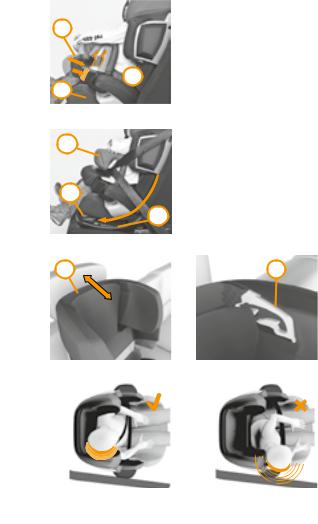
|
|
|
|
|
EINSTELLEN DES SICHERHEITSKISSENS – ECE GRUPPE 1 (9 - 18 KG) |
|
|
|
|
|
|
p |
|
|
Durch das gleichzeitige betätigen der beiden tasten (z) gleitet das sicherheitskissen |
||
|
|
(p) automatisch in seine vorderste Position. Durch das loslassen der tasten wird das |
|||
|
|
|
|
|
sicherheitskissen in seiner Position fixiert. |
|
|
|
|
|
Die seitenteile des sicherheitskissens mit den Verstelltasten (z) passen exakt |
|
|
z |
|
|
in die armlehnen des sitzkissens und dienen zur abstützung des sitzes (d) am |
|
|
|
|
sicherheitskissen (p). |
|
|
|
|
|
||
d |
|
|
stellen sie das sicherheitskissen so ein, dass das sicherheitskissen am kind anliegt, |
||
|
|
|
|
|
ohne dass es auf den körper des kindes drückt. |
|
|
|
|
|
Warnung! Das Sicherheitskissen (p) darf nur in Verbindung mit dem Rahmen (w) und |
|
|
|
|
|
bis maximal 18 kg verwendet werden. |
p |
|
|
SITZUND LIEGEPoSITIoN – ECE GRUPPE 1 (9 - 18 KG) |
||
|
|
|
|
|
|
|
|
|
|
|
um den CYbeX kindersitz in die liegeposition zu bringen, muss das fahrzeugeigene |
|
|
|
|
|
gurtsystem (f) nicht geöffnet werden. |
v |
|
|
– Wenn das kind während der fahrt einschläft, betätigen sie die einstelltaste (v) und |
||
|
|
der sitz gleitet automatisch nach unten. |
|||
|
|
|
|
|
– um nach dem aussteigen des kindes den sitz von der liegein die aufrechte |
|
|
|
|
|
sitzposition zurückzubringen, betätigen sie erneut die einstelltaste (v) und der sitz |
|
|
|
|
|
gleitet mit leichtem Druck gegen das sitzkissen wieder nach oben. |
|
|
|
|
|
|
|
|
|
|
|
Warnung! Achten Sie immer darauf, dass die Verstelltaste (v) in Liegesowie in |
|
|
|
|
|
Sitzposition hörbar einrastet. Die Liegeposition ist nur mit Sicherheitskissen (p) und |
r |
|
t |
|||
|
Grundrahmen (w) für die ECE Gruppe 1 (von 9-18 kg) zugelassen! |
||||
|
|
|
|
|
Hinweis! achten sie immer darauf, dass der becken und der schultergurt immer gut |
|
|
|
|
|
gespannt sind. |
|
|
|
|
|
NEIGUNGSVERSTELLBARE KoPFSTüTZE |
|
|
|
|
|
Der CYbeX Pallas 2 hat eine neigungsverstellbare kopfstütze (r), die hilft, dass der kopf |
|
|
|
|
|
ihres kindes beim einschlafen nicht so leicht nach vorne fällt. außerdem trägt diese |
|
|
|
|
|
verstellbare kopfstütze zum komfort für ihr kind beim autofahren bei. |
|
|
|
|
|
Hinweis! achten sie bitte darauf, dass der kopf des kindes immer in kontakt mit der |
|
|
|
|
|
neigungsverstellbaren kopfstütze bleibt, da die kopfstütze nur so ihre optimierte |
|
|
|
|
|
seitenaufprall-schutzfunktion erfüllen kann. |
|
|
|
|
|
Durch leichtes anheben der kopfstütze kann die neigung der kopfstütze (r) in 3 |
|
|
|
|
|
verschiedenen Positionen eingestellt werden. |
|
|
|
|
|
Warnung! Auf keinen Fall darf die Einrastvorrichtung (t) mit Gegenständen blockiert |
|
|
|
|
|
werden. Im Falle eines Unfalls muss die Leichtgängigkeit der Neigungsverstellung |
|
|
|
|
|
gewährleistet sein, da es sonst eventuell zu Verletzungen Ihres Kindes kommen kann. |
|
|
|
|
|
|
|
|
|
|
|
|
11
Safety cushion ADJUSTMENT - ECE GROUP 1 (9-18 KG)
By pushing the buttons (z) the safety cushion (p) will slide into the forefront position. By releasing the buttons (z) the safety cushion (p) will be locked in position.
The side parts of the safety cushion (p) fit exactly into the armrests of the booster cushion. They connect the safety cushion (p) and the booster (d).
The safety cushion should be well adjusted to touch the child‘s chest without exerting any pressure on the child`s body.
Warning! Safety cushion (p) may only be used in conjunction with the main frame (w) and only up to a mximum weight of 18kg!
Regolazione del cuscino anticrash - ECE Gruppo 1 (9 -18 kg)
Premendo i pulsanti (z) il cuscino anticrash (p) può scorrere in avanti. Rilasciando i pulsanti (z) il cuscino anticrash (p) viene bloccato in posizione.
Le parti laterali del cuscino anticrash (p) si integrano perfettamente nei braccioli del cuscino di seduta. Permettono la connessione del cuscino anticrash (p) alla base di seduta (d).
Il cuscino anticrash dovrà essere regolato correttamente verso il busto del bambino. Abbastanza vicino da proteggerlo, ma non tanto da opprimerlo.
Attenzione! Cuscino anticrash (p) e struttura base (w) devono necessariamente essere usati congiuntamente ma solo fino a quando il bambino raggiunge un peso di al massimo 18 kg!
SITTING AND RECLINING POSITION – ECE GRUPPE 1 (9 - 18 KG)
It is not necessary to open the car belt system (f), to bring the CYBEX child seat into reclining position.
––When the child is about to fall asleep, pull the handle (v) and the seat slides down automatically.
––When the child is no longer in the seat you can move the seat into an upright position by again pulling the handle (v) and slightly pressing against the booster.
Warning! Make sure that the handle (v) of the reclining mechanism is audibly locked in any position. The reclining position is only approved for ECE Group 1 (9-18 kg), in conjunction with main frame (w) and safety cushion (p)!
Note! Make sure that both lap belt and the shoulder belt are always tightly fastened.
Posizione di seduta e reclinazione – ECE Gruppo 1 (9-18 kg)
Non è necessario slacciare la cintura di sicurezza (f) per spostare Pallas 2 nella posizione reclinata.
––Quando il bambino sta per addormentarsi basta tirare la maniglia (v) per reclinare automaticamente il seggiolino.
––Quando il seggiolino non è utilizzato può essere rimesso in posizione verticale tirando la medesima leva (v) e spingendo indietro la base di seduta.
Attenzione! Assicurarsi sempre che la maniglia (v) del meccanismo di reclinazione sia bloccata in ogni posizione, sentendo il Click! La posizione reclinata è approvata soltanto per il Gruppo 1 ECE – da 9 a 18 kg - ed in congiunzione con la struttura base
(w) ed il cuscino anticrash (p)!
Nota Bene! Verificare sempre che entrambe le parti della cintura, ventrale e diagonale, siano ben tese ed allacciate.
RECLINING HEAD REST
The CYBEX Pallas 2 has a reclining headrest (r) preventing your child‘s head from falling forward when asleep. Furthermore, this adjustable headrest contributes to the comfort of your child during the car ride.
Note! Please ensure that the child‘s head always remains in contact with the reclining headrest since otherwise the headrest cannot fulfill its optimal side-crash protective function.
By slightly lifting the headrest, the inclination of the headrest (r) can be adjusted in three different positions.
Warning! The locking device (t) must never be blocked by any objects! In case of an accident, the free movement of the inclination must be guaranteed since otherwise your child might be injured.
Reclinazione dell’ appoggiatesta
Il seggiolino CYBEX Pallas 2 è dotato di un appoggiatesta reclinabile (r) che impedisce alla testa del bambino di protendersi in avanti durante il sonno. Inoltre, fornisce al bambino un maggiore comfort durante il viaggio.
Avvertenza! Verificare che la testa del bambino si trovi sempre a contatto con l‘appoggiatesta reclinabile onde evitare che l’ottima funzione di questo dispositivo di sicurezza in caso di impatto laterale sia vanificata.
Sollevando leggermente l’appoggiatesta (r) è possibile regolarne l’inclinazione in tre diverse posizioni.
Attenzione! Il sistema di bloccaggio (t) non deve mai essere contrastato da ostacoli. E’ indispensabile verificare che il meccanismo di reclinazione sia libero da impedimenti per prevenire ferite al bambino in caso di incidente.
12
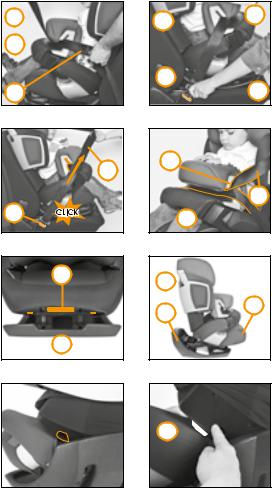
f  x
x 
n
f
l
v
 q
q 
p 
 x
x
m
 l
l
x
f
n 
a
w d
d
s 
ANSCHNALLEN mITTELS SICHERHEITSKISSEN - ECE GRUPPE 1 (9-18 KG)
1.setzen sie das kind in den kindersitz.
2.legen sie nun das bereits eingestellten sicherheitskissen ein (siehe kap. einstellen des sicherheitskissens).
3.nehmen sie den beckengurt (n) und legen sie ihn in die dafür vorgesehene gurtführung (x) im sicherheitskissen.
Warnung: Gurt auf keinen Fall verdrehen!
4.stecken sie die gurtzunge (m) ins gurtschloss (l). Dieses muss mit einem hörbaren „klick“ einrasten .
5.nehmen sie nun den schultergurtgurt (f) und spannen sie durch ziehen den beckengurt (n) vor.
6.legen sie anschließend den schultergurtteil parallel zum beckengurt in diesselbe gurtführung (x).
7.ziehen sie den gurt (f) straff und achten sie dabei darauf, dass beide gurte (f) und
(n) über die gesamte breite innerhalb der gurtführung (x) verlaufen.
UmBAU VoN GRUPPE 1 (9-18KG) ZU GRUPPE 2/3 (15-36 KG)
1.entfernen sie das sicherheitskissen (p).
2.Drücken sie die beiden entriegelungstasten (q) an der unterseite des sitzkissens
(d) und ziehen sie es bis zum ersten Widerstand vom rahmen (w) weg.
3.betätigen sie nun die einstelltaste (v), die zentral unter dem sitzkissen (d) liegt, und ziehen sie den sitz komplett vom rahmen (w) ab.
4.zum entfernen der abstandhalter (s) bringen sie zuerst den sitz in eine liegeposition.
5.ziehen sie den bezug der rückenlehne (a) hoch, um die fingeröffnung an der rückseite der rückenlehne freizulegen.
6.betätigen sie die entriegelungstaste im inneren der rückenlehne und lösen sie nun den abstandhalter (s) von unten ab.
7.Wiederholen sie den Vorgang auf der anderen seite.
Hinweis! bewahren sie die demontierten teile gut geschützt und gemeinsam auf.
Warnung! Beim Wiederzusammenbau gehen Sie genau in umgekehrter Reihenfolge vor. überprüfen Sie zuvor anhand der Anleitung, ob alle Teile vorhanden sind.
13
Fastening of seatbelt with safety cushion attached - ECE group 1 (9-18 kg)
1.Place the child in the car seat.
2.Attach the previously adjusted safety cushion to the child seat (see chapter „Safety cushion Adjustment“).
3.Take the lap belt (n) and slide it into the dedicated belt routings (x) (marked red) of the safety cushion.
Warning! Never twist the belt!
4.Insert the belt guide (m) into the belt buckle (l). Listen for an audible „CLICK“
5.Now take the shoulder belt (f) and pull it to tighten lap belt (n).
6.6. Please slide the shoulder belt (f) parallely to the lap belt into the same belt routing (x).
7.Pull the belt (f) tight and make sure that the belts (f) and (n) are running completely inside (over the whole width) of the belt routing (x).
Come allacciare la cintura di sicurezza con il cuscino anticrash: ECE - Gruppo 1 (9-18 kg)
1.Sedere il bambino sul seggiolino.
2.Fissare il cuscino anticrash precedentemente regolato al seggiolino. (Vedere la sezione Regolazioni relativa al cuscino anticrash).
3.Far passare la parte ventrale della cintura (n) nell’apposita guida (x) del cuscino anticrash, contrassegnata con il colore rosso.
Attenzione! La cintura non deve MAI essere attorcigliata!
4.Inserire il gancio della cintura (m) nella fibbia (l). Deve udirsi il CLICK!
5.Tirare la parte diagonale della cintura (f) per stringere al massimo la parte ventrale
(n).
6.Far passare la parte diagonale della cintura (f) parallelamente alla parte ventrale, all’interno della stessa guida (x).
7.Tirare la cintura (f) per ottenere la massima tensione e verificare che entrambe le parti della cintura di sicurezza (f e n) scorrano completamente all’interno della guida (x) per tutta la sua lunghezza.
Change over from group 1 (9-18kg) to group 2/3 (15-36 kg)
1.Remove the safety cushion (p).
2.Press the release buttons (q) until you can feel some resistance (d) and pull it away from the main frame until you feel a resistance.
3.Now pull the reclining handle (v) situated centrally on the bottom of the booster
(d) and completely pull the booster off the frame (w) .
4.For removal of the spacers (s) it is recommended to bring the seat into reclining position.
5.Pull up the backrest cover (a) to reveal the finger hole on the back side of the backrest.
6.Push the release button inside the finger hole and pull the spacers (s) out of the backrest.
7.Repeat this procedure on the other side of the backrest.
Note! Please keep all spare parts together and store them properly.
Warning! For reassembly please proceed with these steps in reverse order. Check the instruction manual in advance to make sure no parts are missing.
Passaggio da Gruppo 1 (9-18 kg) al Gruppo 2/3 (15-36 kg)
1.Rimuovere il cuscino anticrash (p).
2.Premere le levette di sblocco (q) poste sotto la base di seduta (d) e tirare in avanti la seduta fino a sentire un blocco.
3.A questo punto tirare la maniglia per la reclinazione (v) che si trova al centro, sotto la base di seduta (d) e staccare completamente la base di seduta dalla struttura
(w).
4.Per la rimozione dei distanziatori (s) raccomandiamo di mettere il seggiolino in posizione reclinata.
5.Sollevare il rivestimento dello schienale (a) per esporre il foro sul retro dello schienale.
6.Premere il pulsante di sblocco al suo interno e rimuovere i distanziatori (s), estraendoli dallo schienale.
7.Ripetere l’operazione anche sull’altro lato dello schienale.
Nota Bene! Conservare tutte le parti insieme ed in un luogo adatto.
Attenzione! Per il “riassemblaggio” ripetere le operazioni sopradescritte nell’ordine inverso. Controllare sempre il manuale d’istruzioni per verificare che non manchi alcuna parte.
14
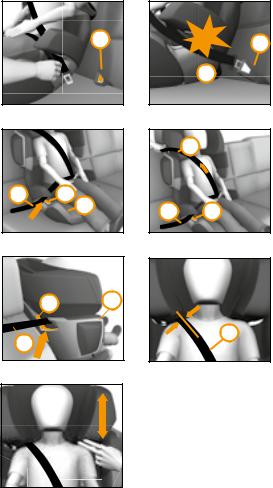
l
n |
k d |


 l m
l m 

f
n  k
k
g |
e |
f |
f |
|
Anschnallen ohne Sicherheitskissen - ECE Gruppe 2/3 (15-36kg)
Setzen Sie Ihr Kind in den Kindersitz. Ziehen Sie den Dreipunktgurt weit heraus und führen Sie diesen vor Ihrem Kind entlang zum Gurtschloss (l)
Warnung! Gurt auf keinen Fall verdrehen.
Stecken Sie die Gurtzunge (m) ins Gurtschloss (l). Dieses muss mit einem hörbaren „CLICK“ einrasten.
Als nächstes legen Sie den Beckengurt (n) in die unteren Gurtführungen (k) des Kindersitzes ein. Ziehen Sie nun den Beckengurt (n) straff, indem Sie kräftig am Diagonalgurt (f) ziehen. Je enger der Gurt anliegt, desto besser kann er vor Verletzungen schützen. Auf der Seite des Gurtschlosses müssen Diagonalgurt (f) und Beckengurt (n) zusammen in die untere Gurtführung (k) eingelegt sein.
Warnung! Das Fahrzeuggurtschloss (l) darf keinesfalls in die untere Gurtführung
(k) hineinreichen. Ist die Gurtpeitsche zu lang, ist der Sitz nicht für dieses Fahrzeug geeignet.
Der Beckengurt (n) sollte auf beiden Seiten des Sitzkissens (d) in den unteren Gurtführungen (k) liegen.
Hinweis! Bringen Sie Ihrem Kind von Anfang an bei, immer auf eine straffe Gurtführung zu achten und bei Bedarf, selbst den Gurt festzuziehen.
Warnung! Der Beckengurt (n) muss auf beiden Seiten so tief wie möglich über der Leistenbeuge Ihres Kindes verlaufen, um im Falle eines Unfalls optimal wirken zu können.
Nun führen Sie den Diagonalgurt (f) durch die obere rote Gurtführung (g) in der Schulterstütze (e), bis er sich innerhalb der Gurtführung befindet.
Achten Sie bitte darauf, dass der Diagonalgurt (f) zwischen Schulteraußenkante und Hals Ihres Kindes verläuft. Falls erforderlich, passen Sie durch Verstellen der Kopfstützenhöhe den Gurtverlauf an. Die Höhe der Kopfstütze kann auch noch im Auto eingestellt werden.
IST IHR KIND RICHTIG GESICHERT?
Um die bestmögliche Sicherheit Ihres Kindes zu gewährleisten, prüfen Sie bitte vor Beginn der Fahrt, ob …
––der Beckengurt (n) auf beiden Seiten des Sitzkissens in den unteren Gurtführungen
(k) verläuft.
––der Diagonalgurt (f) auf der Gurtschlossseite auch in der unteren Gurtführung (k) des Sitzkissens verläuft.
––der Diagonalgurt (f) durch die rot markierte Gurtführung (g) der Schulterstütze verläuft.
––der Diagonalgurt (f) schräg nach hinten verläuft.
––der gesamte Gurt straff ist und nicht verdreht anliegt.
15
Fastening of seat belt without the safety cushion - ECE group 2/3 (15-36 kg)
Put your child in the child seat. Pull out the three-point belt and lead it in front of your child to the belt buckle (l).
Warning! Never twist the belt!
Insert the belt tongue (m) into the belt buckle (l). If you hear an audible „CLICK“ it is securely locked.
Put the lap belt (n) in the bottom belt guides (k) of the child seat. Now pull the lap belt (n) tight by pulling the diagonal belt (f) until there is no slack. The tighter the belt the better it can protect from injuries. The diagonal belt and lap belt should both be inserted in the bottom belt guide at the side of the belt buckle.
Warning! The belt buckle of the car seat (l) must under no circumstances reach into the bottom belt guide (k). If the belt strap is too long, the child seat is not suitable for this vehicle.
The lap belt (n) should be placed in the bottom belt guides (k) on both sides of the seat (d).
Note! Teach your child from the beginning to always pay attention to a tight belt and that it should pull the belt tight by itself if necessary.
Warning! The lap belt (n) must, on both sides, run as low across the groin of your child as possible in order to take optimal effect in case of an accident.
Now lead the diagonal belt (f) through the upper red belt guide (g) in the shoulder rest (e) until it is inside the belt guide.
Please make sure that the diagonal belt (f) runs between the outer edge of the shoulder and your child‘s neck. If necessary, adjust the running of the belt by adjusting the height of the headrest. The height of the headrest can still be adjusted in the car.
Come allacciare la cintura di sicurezza senza il cuscino anticrash: ECE - Gruppo 2/3 (15-36 kg)
Collocare il bambino nel seggiolino di sicurezza. Tirare la cintura di sicurezza a tre punti e farla passare davanti al bambino, fino al punto di ancoraggio.
Attenzione! Non attorcigliare MAI la cintura!
Sistemare la guida della cintura (m) nel dispositivo di chiusura (l). L’aggancio corretto sarà segnalato dal “CLICK”. Sistemare la cintura per le gambe (n) nelle guide inferiori
(k) del seggiolino. Quindi regolare la lunghezza del tratto di cintura per le gambe (n) tirando la parte diagonale della cintura (f) in modo da eliminare qualsiasi lasco. Un fissaggio ottimale della cintura garantisce una maggiore protezione. La cintura di sicurezza diagonale e quella per le gambe dovrebbero essere inserite nella guida inferiore della cintura a lato del dispositivo di chiusura.
Attenzione! Il dispositivo di aggancio della cintura di sicurezza dell’auto (l) non deve in alcun caso arrivare all’altezza delle fessure in cui scorrono le cinture del seggiolino (k). Se il dispositivo di aggancio delle cinture è troppo lungo, il seggiolino non è adatto a questo tipo di autoveicolo.
La cintura per le gambe (n) deve essere inserita nelle apposite guide (k) disposte su ambo i lati della seduta (d).
Avvertenza! Insegnate fin da subito al Vostro bambino di prestare attenzione alla regolazione della cintura, che dovrà essere sempre ben tesa. Insegnategli a stringerla da solo se necessario.
Attenzione! La cintura di sicurezza per le gambe deve scorrere all’interno delle guide da ambo i lati per garantire la massima protezione in caso di incidente.
A questo punto inserire la cintura di sicurezza diagonale (f) nella fessura di sicurezza del seggiolino all’altezza delle spalle (e). Prestare la massima attenzione affinché la cintura diagonale (f) passi tra il collo del bambino ed il lato esterno della spalla. Se necessario, sistemarne la posizione regolandol’altezza dell’appoggiatesta. L’altezza dell’appoggiatesta può essere regolata anche quando il seggiolino è fissato all’interno dell’auto.
IS YOUR CHILD PROPERLY SECURED?
In order to guarantee the best possible safety for your child, please check prior to the ride, whether …
––the lap belt (n) runs in the bottom belt guides (k) on both sides of the child seat.
––the diagonal belt (f) also runs in the bottom belt guide (k) of the child seat on the side of the belt buckle.
––the diagonal belt (f) runs through the belt guide (g) of the shoulder rest, marked red
––the seat belt (f) runs diagonally towards the back.
––the entire belt sits tight and is not twisted.
Il bambino è allacciato correttamente?
Per garantire la massima sicurezza del bambino è necessario verificare i seguenti punti prima di avviare il veicolo:
––la cintura di sicurezza per le gambe (n) deve passare attraverso le guide di sicurezza (k) su ambo i lati del seggiolino.
––la cintura di sicurezza diagonale (f) deve essere inserita anche nella guida di sicurezza inferiore (k) del seggiolino a lato del dispositivo di aggancio della cintura di sicurezza.
––la cintura di sicurezza diagonale (f) deve passare attraverso la guida di sicurezza
(g) delle spalle contrassegnata in rosso
––la cintura di sicurezza (f) scorre in diagonale all’indietro.
–– tutta la cintura dev’essere ben tesa e non attorcigliata. |
16 |
|
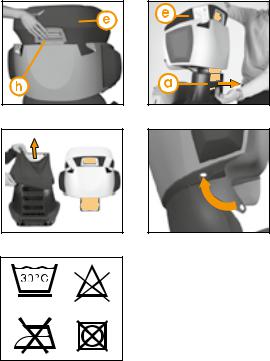
PFLEGE
Um die größtmögliche Schutzwirkung Ihres Kindersitzes zu gewährleisten, ist es unbedingt notwendig, dass Sie folgendes beachten:
––Alle wichtigen Teile des Kindersitzes sollten regelmäßig auf Beschädigungen kontrolliert werden. Die mechanischen Bauteile müssen einwandfrei funktionieren.
––Es ist unbedingt darauf zu achten, dass der Kindersitz nicht zwischen harten Teilen wie Fahrzeugtür, Sitzschiene usw. eingeklemmt wird und dadurch beschädigt werden kann.
––Der Kindersitz muss z.B. nach einem Sturz unbedingt vom Hersteller überprüft werden.
ENTFERNEN DES BEZUGES
Der Bezug besteht aus vier Teilen, die entweder mit Klettband, Druckknöpfen oder Knopflöchern am Kinderautositz befestigt sind. Sobald Sie alle Befestigungen lösen, können die Einzelteile abgenommen werden.
Um den Bezug wieder zu befestigen, verfahren Sie in umgekehrter Reihenfolge.
Warnung! Der Kindersitz darf keinesfalls ohne Bezug verwendet werden.
ENTFERNEN DES SITZBEZUGS VON DER SITZLEHNE
1.Ziehen Sie durch Betätigen des Verstellgriffs (h) die Kopfstütze (e) soweit wie möglich heraus.
2.Betätigen Sie den Verstellgriff (h) und ziehen Sie gleichzeitig an der unteren Kante der obersten Rippe der Sitzlehne (a), um die Kopfstütze (e) zu lösen. Ziehen Sie diese nun komplett heraus.
3.Jetzt können Sie den Sitzbezug nach oben hin entfernen.
4.Um die Rückenlehne wieder zusammenzubauen, stecken Sie mit betätigtem Verstellgriff (h) die Kopfstütze (e) in die Rückenstütze (a).
REINIGUNG
Es ist darauf zu achten, dass nur ein Original CYBEX Sitzbezüge verwendet wird, da auch der Bezug ein wesentlicher Bestandteil der Funktion ist. Ersatzbezüge erhalten Sie im Fachhandel.
Hinweis!BittedenBezugvordererstenVerwendungwaschen.DerBezugdarfbei30°C im Schonwaschgang gewaschen werden. Sollten Sie mit mehr als 30°C waschen, kann es zu Ausfärbungen kommen. Bitte den Bezug gesondert von anderer Wäsche waschen und keinesfalls maschinell trocknen! Den Bezug keinesfalls in der prallen Sonne trocknen! Die Kunststoffteile können mit einem milden Reinigungsmittel und warmen Wasser gewaschen werden.
Warnung! Bitte auf keinen Fall chemische Reinigungsoder Bleichmittel verwenden!
17
PRODUCT CARE
In order to guarantee the best possible protection of your child seat, it is necessary that you take note of the following:
––All important parts of the child seat should be examined for any damages on a regular basis. The mechanical parts must function flawlessly.
––It is essential that the child seat does not get jammed between hard objects e.g. like the door of the car, seat rail etc. causing possible damage to the seat.
––The child seat must be examined by the manufacturer after a fall or similar situations.
REMOVING THE SEAT COVER
The seat cover consists of four parts which are fixed to the seat either by velcros, press buttons or button holes. Once you have released all fixations, the cover parts can be removed.
In order to put the covers back on the seat, proceed in the reversed order as removing them.
Warning! The child seat must never be used without the cover.
REMOVING THE SEAT COVER FROM THE BACKREST
1.Pull the headrest (e) into top position, by using release handle (h).
2.To release the headrest (e), simultaneously pull handle (h) and the lower rim of the upper rib of the backrest (a). Now the headrest (e) can be completely detached.
3.Now the cover can be removed.
4.For reassembly pull the adjustment handle (h) and insert the headrest (e) into the backrest (a).
Manutenzione del prodotto
Per garantire i massimi standard di sicurezza del seggiolino è necessario prendere nota dei seguenti accorgimenti:
––Tutte le parti importanti del seggiolino di sicurezza per auto devono essere sottoposte ad un regolare controllo per verificare eventuali danni. Le parti meccaniche devono funzionare correttamente.
––E’ essenziale che il seggiolino non venga danneggiato a causa di un eventuale schiacciamento tra il sedile dell’auto e la porta o da altri ostacoli solidi.
––Il seggiolino dovrà essere inviato al produttore per un controllo in caso di caduta o altri eventi similari.
Rimozione del rivestimento
Il rivestimento seduta è composto da 4 parti, fissate al seggiolino con velcro, bottoni a pressione o asole. Una volta sganciati tutti i punti di fissaggio è possibile rimuovere le varie parti del rivestimento.
Per reinserire il rivestimento, eseguire nuovamente le operazioni nell’ordine i nverso.
Attenzione! IIl seggiolino di sicurezza non deve mai essere utilizzato senza l’apposito rivestimento.
Rimozione del rivestimento schienale
1.Sollevare l’appoggiatesta (e) fino al punto di massima estensione, usando la maniglia di sblocco (h).
2.Per rilasciare l’appoggiatesta (e) tirare contemporaneamente la maniglia
(h)e il lembo inferiore della copertura dello schienale (a). A questo punto l’appoggiatesta (e) può essere staccato.
3.E il rivestimento può essere tolto.
4.Per il rimontaggio tirare la maniglia di regolazione (h) ed inserire l’appoggiatesta
(e)nello schienale (a).
CLEANING
It is important to use only an original CYBEX seat cover since the cover is also an essential part of the function. You may obtain spare covers at your retailer.
Note! Please wash the cover before you use it the first time. Seat covers are machine washable at max. 30°C on delicate cycle. If you wash it at higher temperature, the cover fabric may lose colour. Please wash the cover separately and never dry it mechanically! Do not dry the cover in direct sunlight! You can clean the plastic parts with a mild detergent and warm water.
Warning! Please do not use chemical detergents or bleaching agents under any circumstances!
Pulizia
Il rivestimento è una parte importante per il funzionamento del seggiolino ed è indispensabile utilizzare soltanto rivestimenti originali CYBEX Pallas 2. Rivestimenti di ricambio originali sono disponibili presso i rivenditori autorizzati.
Nota Bene! E‘ consigliato il lavaggio prima del primo utilizzo. Rivestimenti lavabili in lavatrice, ciclo delicato max 30°. L‘uso di temperature più elevate può scolorire i tessuti. Lavare separatamente e non asciugare mai a macchina. Non asciugare alla luce diretta del sole. Le parti in plastica possono essere pulite con detergente neutro e acqua tiepida.
Attenzione! Non usare mai prodotti chimici o sbiancanti per la pulizia!
18
